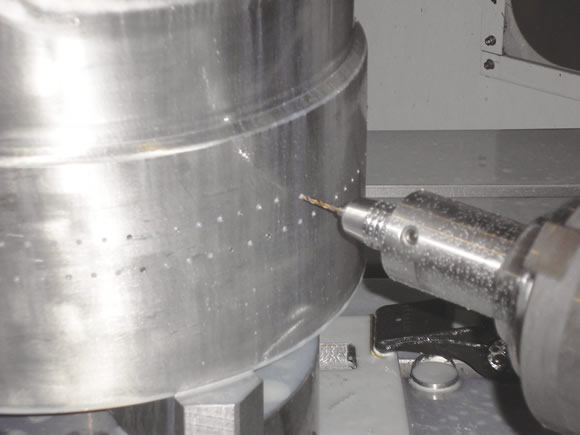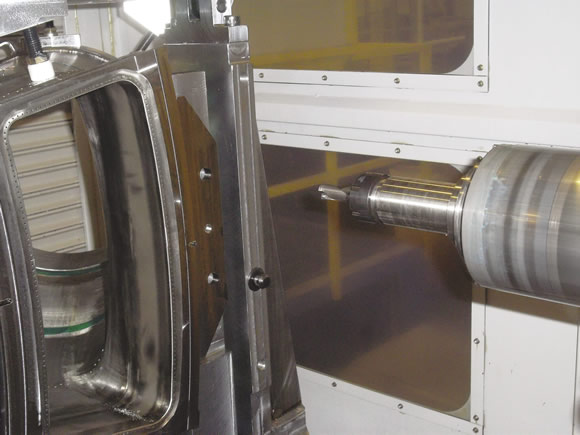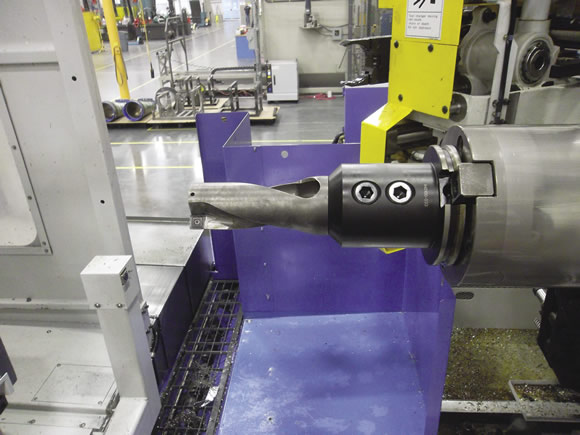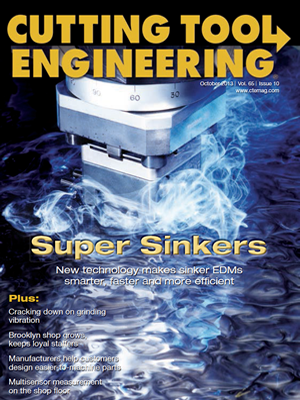The variety of drills on the market seems limitless, and each salesman says he has an offering that is better than the rest. The substrates, point geometries and coatings vary greatly—along with the price. I consider several factors when purchasing a drill and try to find the balance between price and performance that gives the best cost advantage while maintaining part quality and productivity.
The first consideration is the number of holes to be produced. A common misconception is that carbide is always the best substrate choice. An expensive, high-performance carbide drill may provide the highest penetration rate and shortest cycle time. However, if the number of holes being drilled is low, there may be a cost advantage to applying a less-expensive alternative, such as a HSS drill, because the tool cost savings can trump the increased cycle time.

Savannah Machinery Works found that a Walter Titex 3mm (0.12 ") drill provides superior performance and long tool life when cutting Hastelloy X. The point geometry allows drilling on the part radius without using a spot drill.
Also consider hole size. Carbide drills above ½ " (12mm) in diameter are expensive, and indexable-insert drills have limited selection in sizes below 5/8 " (16mm). Therefore, a HSS drill might be better for making holes from ½ " to 1 ". On the other hand, an indexable drill may be more practical than a HSS or carbide drill for producing holes larger than 1 ".
Because high-performance carbide drills can hold tight size and geometric tolerances, I have opted for them when they eliminate a secondary operation, such as reaming. In addition, an indexable drill can be applied like a boring bar on a lathe. After drilling the hole, the indexable drill is stepped off center so the periphery insert enlarges the hole to the desired diameter, possibly eliminating the need for a boring tool.

This Sandvik Coromant 17mm (0.67 ") indexable-insert drill is more cost-effective than a solid-carbide drill for producing a low number of holes in a Hastelloy X bracket, according to Savannah Machinery Works. HSS is not capable of drilling the material without risking catastrophic failure.
Besides reducing the number of tools by combining operations, reducing setup is a common goal when machining. If a drill can be used on a variety of parts, selecting an expensive, high-performance drill to extend tool life and minimize tool changes generally cuts costs. It may be possible to produce various hole sizes by drilling one size and circular interpolating with an endmill to enlarge holes that are larger than the drill diameter all in one setup.
Workpiece material is another consideration. A basic HSS drill performs well in carbon steel but tool life is poor when drilling abrasive materials like cast iron or die cast aluminum, justifying a costlier alternative like carbide. And P/M HSS drills effectively cut austenitic (300 series) stainless steels and similar materials. In these materials, P/M drills often have penetration rates similar to carbide and cost significantly less.
Matching the drill to the machine tool is yet another consideration. High-performance drills require rigid machine tools that have spindles with minimal runout. Vibration from loose ways and excessive spindle runout can damage the fragile edges of carbide drills, causing premature failure. Large-diameter drills, especially large indexable drills, may require more torque than the spindles of some light-duty machines can supply. This scenario may require drilling smaller-than-specified holes and enlarging them via circular interpolation or boring.
Toolholders play a critical role in drill performance. The toolholder is the interface between the drill and the spindle, so it is important to balance this relationship. Low-quality toolholders can allow drills to run out, which reduces geometric accuracy and tool life. If the holder’s grip is insufficient, the drill can slip. This causes incorrect hole depth, putting other tools at risk of failure when they enter holes that are too shallow. Insufficient grip can also allow chatter, damaging the cutting edges on carbide drills and ultimately causing catastrophic failure. The best machine tool is only as good as the toolholder in its spindle.

A Sandvik Coromant 38mm (1.50 ") indexable-insert drill is a good choice for producing holes in Hastelloy X, according to Savannah Machinery Works. The holes could have been drilled with a smaller drill, such as the 17mm one, and enlarged via circular interpolation or boring, but the shorter cycle time for drilling with the larger indexable tool justifies the expense of these drills. Also, the machines that use the larger drills are dedicated to one part family at SMW, so increasing flexibility is not necessary.
Finally, consider the machining environment and a shop’s practices. If the machinists, toolmakers and programmers are accustomed to using a particular type of drill, it may not be practical to introduce alternatives. For example, I tried to introduce high-performance carbide drills at a machine shop where I used to work. HSS jobber drills had been the standard. The operators applying the HSS tools were accustomed to running them at speeds many times slower than the speeds at which carbide drills can run. I was unable to change the culture, so there was no benefit to using costlier, high-performance carbide drills.
Jobs, work materials and production requirements vary greatly and there is no one definitive method for selecting the proper drill. The correct drill is the one that enables a high-quality part to be profitably shipped on time. CTE
About the Author: Christopher Tate is manufacturing engineering lead for machining at Mitsubishi Power Systems, Savannah (Ga.) Machinery Works, a global builder of gas and steam turbines. He has 19 years of experience in the metalworking industry and holds a Master of Science and Bachelor of Science from Mississippi State University. E-mail: [email protected].
Related Glossary Terms
- abrasive
abrasive
Substance used for grinding, honing, lapping, superfinishing and polishing. Examples include garnet, emery, corundum, silicon carbide, cubic boron nitride and diamond in various grit sizes.
- boring
boring
Enlarging a hole that already has been drilled or cored. Generally, it is an operation of truing the previously drilled hole with a single-point, lathe-type tool. Boring is essentially internal turning, in that usually a single-point cutting tool forms the internal shape. Some tools are available with two cutting edges to balance cutting forces.
- boring bar
boring bar
Essentially a cantilever beam that holds one or more cutting tools in position during a boring operation. Can be held stationary and moved axially while the workpiece revolves around it, or revolved and moved axially while the workpiece is held stationary, or a combination of these actions. Installed on milling, drilling and boring machines, as well as lathes and machining centers.
- chatter
chatter
Condition of vibration involving the machine, workpiece and cutting tool. Once this condition arises, it is often self-sustaining until the problem is corrected. Chatter can be identified when lines or grooves appear at regular intervals in the workpiece. These lines or grooves are caused by the teeth of the cutter as they vibrate in and out of the workpiece and their spacing depends on the frequency of vibration.
- endmill
endmill
Milling cutter held by its shank that cuts on its periphery and, if so configured, on its free end. Takes a variety of shapes (single- and double-end, roughing, ballnose and cup-end) and sizes (stub, medium, long and extra-long). Also comes with differing numbers of flutes.
- high-speed steels ( HSS)
high-speed steels ( HSS)
Available in two major types: tungsten high-speed steels (designated by letter T having tungsten as the principal alloying element) and molybdenum high-speed steels (designated by letter M having molybdenum as the principal alloying element). The type T high-speed steels containing cobalt have higher wear resistance and greater red (hot) hardness, withstanding cutting temperature up to 1,100º F (590º C). The type T steels are used to fabricate metalcutting tools (milling cutters, drills, reamers and taps), woodworking tools, various types of punches and dies, ball and roller bearings. The type M steels are used for cutting tools and various types of dies.
- interpolation
interpolation
Process of generating a sufficient number of positioning commands for the servomotors driving the machine tool so the path of the tool closely approximates the ideal path. See CNC, computer numerical control; NC, numerical control.
- lathe
lathe
Turning machine capable of sawing, milling, grinding, gear-cutting, drilling, reaming, boring, threading, facing, chamfering, grooving, knurling, spinning, parting, necking, taper-cutting, and cam- and eccentric-cutting, as well as step- and straight-turning. Comes in a variety of forms, ranging from manual to semiautomatic to fully automatic, with major types being engine lathes, turning and contouring lathes, turret lathes and numerical-control lathes. The engine lathe consists of a headstock and spindle, tailstock, bed, carriage (complete with apron) and cross slides. Features include gear- (speed) and feed-selector levers, toolpost, compound rest, lead screw and reversing lead screw, threading dial and rapid-traverse lever. Special lathe types include through-the-spindle, camshaft and crankshaft, brake drum and rotor, spinning and gun-barrel machines. Toolroom and bench lathes are used for precision work; the former for tool-and-die work and similar tasks, the latter for small workpieces (instruments, watches), normally without a power feed. Models are typically designated according to their “swing,” or the largest-diameter workpiece that can be rotated; bed length, or the distance between centers; and horsepower generated. See turning machine.
- metalworking
metalworking
Any manufacturing process in which metal is processed or machined such that the workpiece is given a new shape. Broadly defined, the term includes processes such as design and layout, heat-treating, material handling and inspection.
- stainless steels
stainless steels
Stainless steels possess high strength, heat resistance, excellent workability and erosion resistance. Four general classes have been developed to cover a range of mechanical and physical properties for particular applications. The four classes are: the austenitic types of the chromium-nickel-manganese 200 series and the chromium-nickel 300 series; the martensitic types of the chromium, hardenable 400 series; the chromium, nonhardenable 400-series ferritic types; and the precipitation-hardening type of chromium-nickel alloys with additional elements that are hardenable by solution treating and aging.
- toolholder
toolholder
Secures a cutting tool during a machining operation. Basic types include block, cartridge, chuck, collet, fixed, modular, quick-change and rotating.


